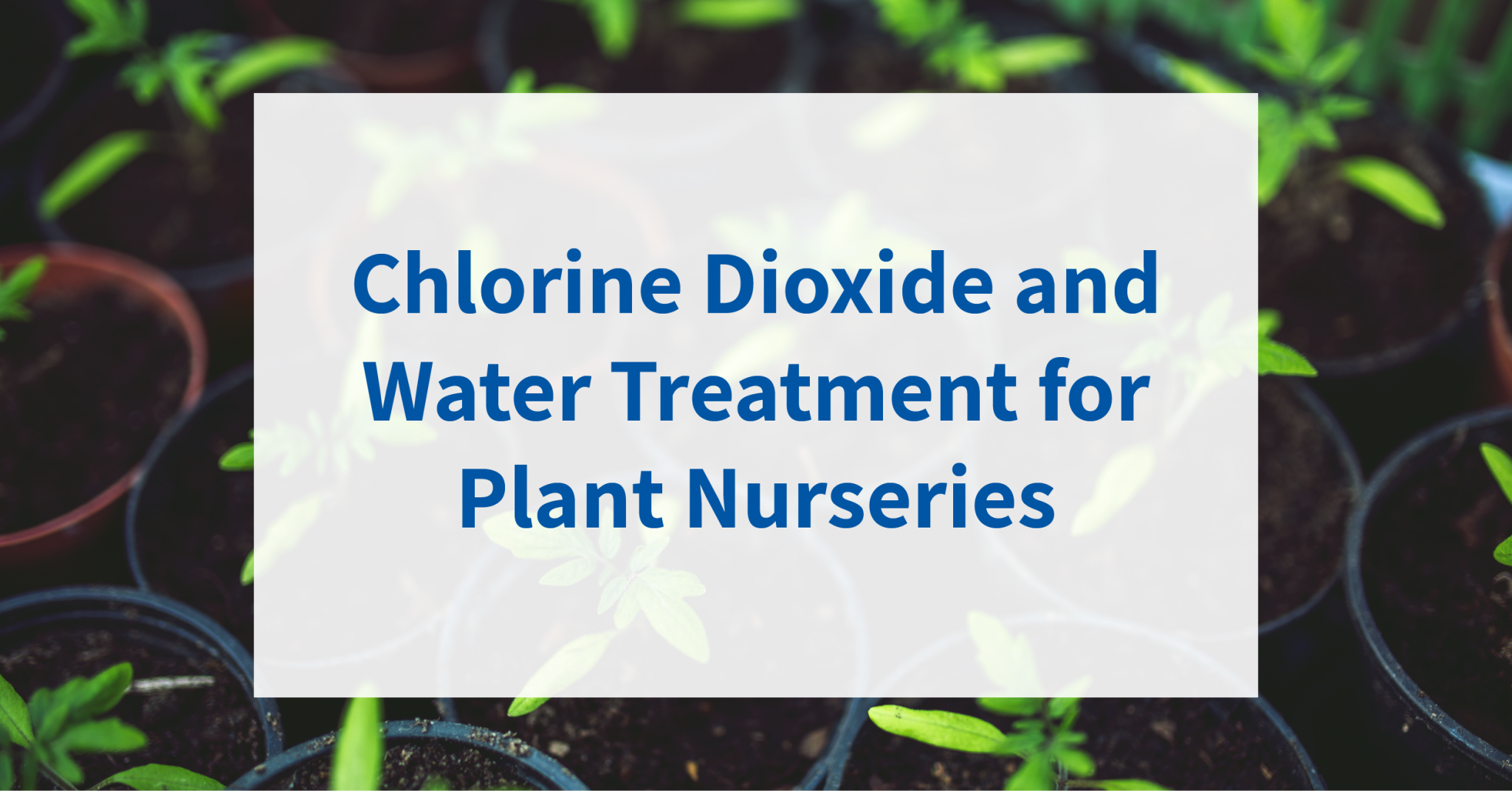
Chlorine Dioxide and Water Treatment for Plant Nurseries
Horticultural facilities, such as plant nurseries, face many of the same water sanitation issues as their agricultural counterparts. These issues include keeping ornamental and food plants healthy, maintaining sanitized equipment, especially irrigation and water recycling systems, and controlling the growth of algae and other harmful microbes.
Treating water with chlorine dioxide solves these problems. It’s also safe, effective at a wide pH range (4-10), and cost efficient for most installations. Finally, chlorine dioxide is odor free, which means it in no way interferes with customers’ experience as they visit a nursery to pick out their plants.
Chlorine dioxide is easy to use. It is a water soluble gas that can be generated on site, as required, then injected directly into irrigation lines. It is an effective disinfectant at a low concentration, below 1.0ppm.
Chlorine Dioxide and Maintaining Plant Health
Most plant nursery owners would agree that keeping plant stock healthy (and therefore attractive to customers) is a big priority. Chlorine dioxide water treatment can be a powerful tool in the fight against plant disease. Even in relatively low amounts, chlorine dioxide added to water can protect against plant pathogens .
For instance, research has shown that chlorine dioxide prevents the spread of Fusarium oxysporum in daffodils during hot water treatment. When used as a dipping agent, it is also effective in reducing Botrytis grey mould in roses. If added to irrigation water, such as that gathered from collection ponds, it kills other pathogens such as Thieloviopsis basicola, Botrytis cinerea, and Clavibacter michiganesis. Chlorine dioxide is effective both if added in small amounts to the regular supply, or as a “shock treatment” at a higher concentration (20-50ppm) in order to target a specific outbreak of a pathogen, or as a periodic cleanse.
Chlorine dioxide is especially useful as a disinfestant as it can be used to control plant diseases during production and post-harvest.
Chlorine Dioxide and Eliminating Biofilm and Algae
The layer of green slime sometimes visible inside a water treatment system is known as biofilm, and it consists of a living mass of organic and inorganic elements that cluster together for survival. Unfortunately, biofilm and the organisms lurking within it thrive on any surface that is in regular contact with water, and that includes the irrigation and return lines, holding and mixing tanks, and containment vessels of typical plant nursery irrigation equipment. Biofilm also grows quickly inside liquid fertilizer lines. If its development is left unchecked, it can block pipes, affecting water flow and pressure, as well as spreading pathogens among plants.
Once again, chlorine dioxide water treatment solves the problem. Once dissolved in water, chlorine dioxide moves freely within the irrigation system. It attacks the surface of the biofilm, destroying it right down to the surface it sits on and, if part of a constant injection system, stops it from re-establishing itself. Chlorine dioxide prevents biofilm regrowth at concentrations as low as 0.25ppm in irrigation water.
Looking for an easier way to generate Chlorine Dioxide on site?
Chlorine Dioxide and Irrigation, Runoff, and Water Recycling
Chlorine dioxide can be added to a plant nursery irrigation system with minimal environmental consequences— as long as levels are constantly monitored. When it reacts with microbes, chlorine dioxide does not form any harmful compounds such as trihalomethane, chloramines, chloroform or other halogenated disinfection by-products (DBPs). It dissipates swiftly once water is exposed to air. This means that treated run-off water can continue to circulate within the irrigation system, reducing labour and waste costs. As chlorine dioxide functions as a disinfectant in such a dilute form, it’s not necessary to clean the system after its use with aggressive chemicals, which may corrode plastic pipes and limit equipment life.
If you’re interested in learning more about chlorine dioxide as a water sanitization solution for plant nurseries and other horticultural businesses, please contact the team at ProDose. We have many years of experience in this specific field and can design, install and maintain every element of your irrigation system, as well as supplying all necessary chemicals. Give us a call today!
If you are interested in using Chlorine Dioxide for your horticultural businesss, please get in touch with us at Prodose. We’d be very happy to talk to you confidentially and on a no-pressure basis.
Recent Articles
Why is Electrochlorination the Best Choice for Swimming Pool Disinfection?
Why is Electrochlorination the best choice for swimming pool disinfection?All swimming pools should be regularly and thoroughly disinfected. This eliminates harmful pathogens that cause sickness in swimmers and prevents the growth of other biological organisms, such...
What is the Electrochlorination Process?
What is the Electrochlorination process?Electrochlorination is the process of applying an electrical current to salt water to produce dilute sodium hypochlorite (bleach) and hydrogen gas. The resultant sodium hypochlorite solution contains between 0.7%-1% chlorine....
Chlorine Dioxide and Legionella Control
Chlorine Dioxide and Legionella ControlLegionella is a bacterium found in soil and water. When it occurs outdoors, it usually does so in low concentrations and doesn’t cause problems. However, when it grows inside artificial water systems, such as hot tubs, hot water...
Keeping it clean: the use of Chlorine Dioxide in the Food and Beverage Sector
Keeping It Clean: the use of Chlorine Dioxide in the Food and Beverage SectorChlorine dioxide is rising in prominence as the best water treatment additive for the food and drinks industry. It’s powerful and economical, and may be a more practical solution for...
Chlorine Dioxide: the practical choice for water treatment in the UK
Find out about Chlorine Dioxide and why it makes such an effective water treatment for the food industry and other industrial practices.
Is Sodium Hypochlorite The Best Way To Treat Water For The Food Industry?
Is Sodium Hypochlorite The Best Way To Treat Water For The Food Industry?Sodium hypochlorite (NaOCl) is a greenish-yellow liquid produced by combining chlorine and sodium hydroxide. Commercial sodium hypochlorite is manufactured by adding chlorine gas to caustic soda,...
